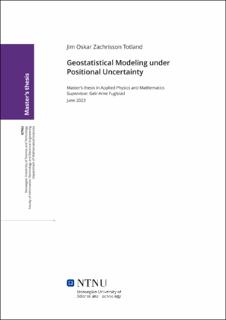| dc.description.abstract | I denne oppgaven undersøker vi posisjonell usikkerhet i geostatistisk modellering. Et sentralt eksempel på posisjonell usikkerhet er bruken av geografisk maskering (geomaskering) ment til å beskytte personvern. Geomaskering brukes i “Demographic and Health Surveys” (DHS) (Burgert et. Al., 2013), der data for indikatorer relatert til befolkning, helse og ernæring i utviklingsland. DHS-data er en verdifull datakilde for å overvåke å fasilitere framgang mot FNs bærekraftsmål, som motiverer undersøkelsen av hvordan posisjonell usikkerhet fra geomaskering påvirker geostatistisk inferens.
Et av denne oppgavens bidrag er å oppsummere geostatistikk-litteraturen som er relevant for posisjonell usikkerhet. I tillegg fokuserer vi på to geomaskerings-strategier, nemlig “disk jittering” og “donut jittering”. For å ta hensyn til usikkerheten disse “jittering shemes” introduserer bruker vi den beregningseffektive numeriske metoden presentert av Altay et. al. (2022a). Vi utvider metoden til å virke for “donut jittering”. I tillegg utforsker vi presisjonen til den numeriske metoden ved å konstruere, implementere og bruke en samplingsbasert inferensmetode ved “jittering”. Ved bruk av den samplingsbaserte metoden demonstrerer vi i noen utvalgte scenarier at den numeriske metoden kan brukes til å effektivt approksimere eksakt inferens ved “jittering”. Deretter utfører vi et simuleringsstudie for å vurdere hvordan moderat og substansiell “jittering” påvirker inferens med den numeriske metoden. Resultatene samsvarer med tidligere arbeider samt teoretisk-baserte forventinger, og demonstrerer at å ta hensyn til “jittering” kan føre til mindre “attenuation” i estimater av kovariatkoeffisientene, mindre bias i målestøyvariansen og bedre prediktive mål. For eksempel med 1000 observasjoner og kovariater som forklarer 68% av variasjonen i observasjonene finner vi at det å ta hensyn til substansiell “donut jittering” gir 18% lavere “root-mean-square” feil sammenlignet med å ignorere “jittering”.
Vi anvender den numeriske metoden på ekte data i en studie av vaksinasjonsdekning i Nigeria, som demonstrerer metodens fleksibilitet med tanke på anvendbarhet til vilkårlige geografier og utvidelse til generaliserte lineære geostatistiske modeller. På grunn av metodens gode kvaliteter og resultater presentert her og i tidligere arbeider anbefaler vi at den numeriske metoden brukes i analyser av DHS-data og i andre tilfeller med posisjonell usikkerhet av samme størrelsesorden. | |
| dc.description.abstract | In this thesis, we study positional uncertainty in the setting of geostatistical modeling. A central example of positional uncertainty is the application of geographic masking (geomasking) intended to protect the privacy of data subjects. Geomasking is applied in Demographic and Health Surveys (DHS) (Burgert et al., 2013), which collect data on population, health and nutrition in many low and middle income countries. These data are important for monitoring and facilitating the progress towards the Sustainable Development Goals, which motivates the study of how positional uncertainty from geomasking impacts geostatistical inference.
A contribution of this thesis is to summarize the geostatistics-literature on positional uncertainty. Additionally, we focus on two geomasking strategies, referred to as disk jittering and donut jittering. To account for the uncertainty these jittering schemes introduce, we use the computationally efficient numerical approach proposed by Altay et al. (2022a). We extend the numerical approach to handle donut jittering. Furthermore, we investigate the accuracy of the method by constructing, implementing and applying a sample-based approach, which demonstrates that the numerical approach may effectively approximate exact inference under jittering. Subsequently, we conduct a simulation study to assess the impact of moderate and substantial jittering on inference with the numerical approach. The results agree with previous work and expectations from theory, where adjusting for jittering leads to less attenuation in estimated covariate coefficients, substantially less biased estimates of the nugget variance and superior predictive measures. For example, when there are 1000 observations and spatial covariates account for 68% of the variation in observations, we find that adjusting for, relative to ignoring, substantial donut jittering gives a median prediction root-mean-square error that is 18% lower. Another contribution of this work is to explore how privacy protection can be evaluated for a given jittering scheme.
We apply the numerical approach to real data in a case study of vaccination coverage in Nigeria, demonstrating its applicability to arbitrary geographies and generalized linear geostatistical models. Due to its favorable qualities and results from this and previous work, we advocate the use of the numerical approach to account for positional uncertainty in geostatistical analyses of DHS data and in other applications with positional uncertainty of comparable scale. | |
